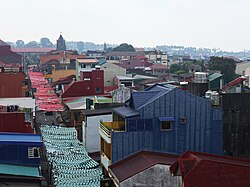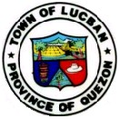Lucban | |
|---|---|
| Municipality of Lucban | |
Clockwise from top: Town Proper, Lucban Church, Plaza, Municipal Hall, Kamay Ni Hesus Healing Shrine | |
Nicknames:
| |
| Motto: Yanong Rikit! Baling Ganda! | |
| Anthem: Lucban, Paraiso kong Bayan | |
 Map of Quezon with Lucban highlighted | |
Location within the Philippines | |
| Coordinates: 14°06′48″N121°33′25″E / 14.1133°N 121.5569°E | |
| Country | Philippines |
| Region | Calabarzon |
| Province | Quezon |
| District | 1st district |
| Founded | August 19, 1578 [1] |
| Barangays | 32 (see Barangays) |
| Government | |
| • Type | Sangguniang Bayan |
| • Mayor | Agustin M. Villaverde |
| • Vice Mayor | Arnel C. Abcede |
| • Representative | Wilfrido Mark M. Enverga |
| • Municipal Council | Members |
| • Electorate | 36,961 voters (2025) |
| Area | |
• Total | 130.46 km2 (50.37 sq mi) |
| Elevation | 521 m (1,709 ft) |
| Highest elevation | 1,872 m (6,142 ft) |
| Lowest elevation | 252 m (827 ft) |
| Population (2024 census) [4] | |
• Total | 54,134 |
| • Density | 414.95/km2 (1,074.7/sq mi) |
| • Households | 12,692 |
| Demonym(s) | Lucbanin, Lukbanin |
| Economy | |
| • Income class | 2nd municipal income class |
| • Poverty incidence | 19.85 |
| • Revenue | ₱ 292.2 million (2022) |
| • Assets | ₱ 576.6 million (2022) |
| • Expenditure | ₱ 212.1 million (2022) |
| • Liabilities | ₱ 109.9 million (2022) |
| Service provider | |
| • Electricity | Manila Electric Company (Meralco) |
| • Water | Apolinario Dela Cruz Waterworks System |
| • Telecommunications |
|
| • Cable TV | BANAHAW CATV |
| Time zone | UTC+8 (PST) |
| ZIP code | 4328 |
| PSGC | |
| IDD : area code | +63 (0)42 |
| Native languages | Tagalog |
| Website | www |
Lucban, officially the Municipality of Lucban (Tagalog : Bayan ng Lukban), is a municipality in the province of Quezon, Philippines. According to the 2024 census, it has a population of 54,134 people. [6]
Contents
- Etymology
- History
- Second World War and Japanese Occupation
- Sampaloc, Quezon
- Geography
- Barangays
- Climate
- Demographics
- Economy
- Government
- Elected officials
- Culture
- Pahiyas festival
- Education
- Primary and elementary schools
- Secondary schools
- Higher educational institutions
- Religious landmarks
- Notable people
- References
- External links
It is dubbed as the Summer Capital, Art Capital, Dance Capital, Tourist Capital, and Rice Capital of Quezon province. The town is also known for its annual Pahiyas Festival, which is held every May 15 in honor of San Isidro Labrador. The municipality is locally the 'Baguio' counterpart of the province.

















